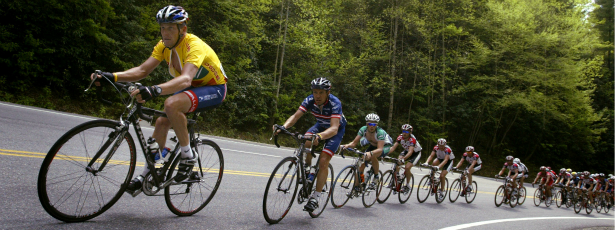Reconciling Lance Armstrong's Story With the Realities of Cancer Survival
He was a hero, an iconic survivor, and he let us down. It's difficult to accept, because he helped.

When Lance Armstrong stepped up to the podium after winning the Tour de France in the summer of 1999, he delivered a potent message. Indeed, it wasn't about the bike. He won over the admiration of people affected by cancer worldwide. The young man proved it's possible to excel in an extreme test of endurance after surgery and chemotherapy for an aggressive, metastatic tumor. He made it seem easy, like you could have your cancer treatment and pedal up a mountain, fast.
LIVESTRONG is an unarguably bright and deceptively simple directive. My sons, then in elementary school, got it on their yellow wrist bands supporting Armstrong's foundation. I got it while riding a stationary bike and swimming laps, however slowly, during chemo for breast cancer. I pushed myself -- his narrative in mind, working and exercising, determined to tough it out no matter what health obstacles I met. My physician colleagues got it, too: "Fantastic!" was the consensus among the doctors in my office. Few of us knew about doping in sports back then. We didn't question Armstrong's achievements. They served perfect testimony to the power of modern medicine and oncology drugs.
In retrospect it's clear that we -- patients and their kids, parents, lovers, nurses, doctors, physical therapists and social workers, all of us in cancerland -- wanted Armstrong to win. We cheered for the young man who gave us a best-case scenario of what life might be after cancer. He delivered hope, not with words so much, as oncologists do, but more powerfully, by physical action. His influence was pervasive, and that's why it matters so much that he misled millions about his strength after receiving medications like vinblastine, etoposide, ifosfamide and cisplatin. Those are harsh drugs, and he came through seemingly unscathed, in phenomenally good shape.
 Armstrong greets a cancer patient in 2009. [Brandon Malone/Reuters]
Armstrong greets a cancer patient in 2009. [Brandon Malone/Reuters]And that's where the medical ethics lies: Armstrong's tale made us feel good and, perhaps, a tad more comfortable prescribing and accepting caustic treatments. Sure, we knew he was as an outlier from the get-go. Few cancer patients step into a clinic having won international sporting events. But his story, deliberately and consciously, overtly or subtly, modified patients' expectations. He pulled our collective perception of what people with illness can do up a notch. Some pushed hard who were older, feebler, or plainly less strong than he. In 2012, people expect doctors to tell it like it is. The same goes for peer patients.
Coming to grips with the evidence about Armstrong's case is painful for more than a few. Reading details of his risky, multi-year use of erythropoietin, testosterone, steroids, other drugs and transfusions before racing is enough to make any cancer or blood specialist wince. Many patients and advocates still support him, as I do in part, but there's a chord of denial running through. He was a hero, an iconic survivor, and he's let us down. This can be difficult to accept, because he helped. There's no taking that back.
In some respects, Armstrong typified the profile of a testicular cancer patient. These are usually germ cell tumors, and affect some 8,500 men in the U.S. each year. Armstrong was 25 years old at the time of diagnosis in September, 1996. The condition occurs most commonly in Caucasian men between the ages of 15 and 34. His tumor had spread, extensively, to his lungs and to his brain. His prognosis was said to be slim. As he recounts in his memoir, he suffered weeks of retching nausea, baldness, weight loss and tiredness so severe his friends outpaced him on flat ground. He experienced pain, fear, catheter complications and worries about loss of insurance and career. But he got better. He started the Lance Armstrong Foundation and, shortly, got his life back on track.
Today, some 13.7 million individuals are alive in the U.S. after a cancer diagnosis. While some return, smoothly, to school or work, or resume their previous activities in good shape, many contend with long-term side effects after treatment. Many are disabled or unemployed. Depression is common. Especially for young people who've had illness, the pressure to succeed can drive exhaustion and, upon failure to meet unrealistically high expectations, feelings of inadequacy.
We might learn a lot, yet, from Armstrong's story. In his book, he says the Tour de France, "filled with peaks, valleys, challenges and new perspectives," is a metaphor for life. If that's the case -- and I believe him in that -- then he's got the chance to ride again, uphill or otherwise. He might reclaim our respect. He has the potential to do good. I hope he'll find the route to doing just that.